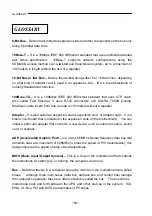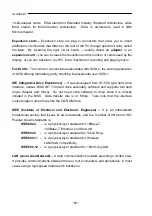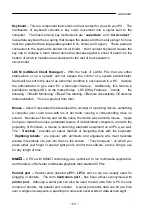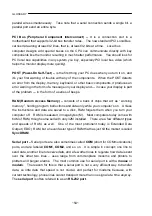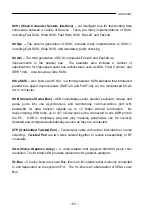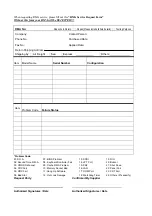
GLOSSARY
~ 53 ~
Keyboard –
This is a component that comes in direct contact for you with your PC. The
mechanism of keyboard converts a key cap’s movement into a signal sent to the
computer. The most common key mechanisms are “
capacitate
” and “
hard contact
”.
Capacitate keyboard has a spring that causes the plastic and the metal plunger to move
near two pads that have large plates (plated in tin, nickel, and copper). These pads are
connected to the keyboard’s printed circuit board. Hard contact keyboard causes the
key cap to collapse a foam rubber dome that presses against a sheet of plastic on the
bottom of which is metallic area connected to the rest of the keyboard’s
circuit board.
LDCM (LANDesk Client Manager) –
With the help of LDCM, PCs that are either
stand-alone or on a network can not escape the control of a system administrator.
Alerts will be sent to the user if an abnormal condition is encountered in a PC. It allows
the administrator to give each PC a thorough check-up. Additionally, this feature is
available to multiple OS’s on the market today. LDCM Key Features include
the
following :
①
Health Monitoring
,
②
Real-Time Alerting
,
③
Remote Accessibility
,
④
Extensive
Instrumentation. This is a product from Intel.
Mouse –
Xerox Corporation first developed the concept of a pointing device, something
a computer user could move with his or her hand, causing a corresponding move on
screen. Because of its size and tail like cable, the device was named a mouse. Apple
Computer made the mouse a standard feature of its Macintosh computers, and with the
popularity of Windows, a mouse is becoming standard equipment on all PCs, as well.
The “
Trackball
” provides an easier method of navigating than with the keyboard.
“
Digitizing tablets
” are popular with architects and engineers who must translate
precise movements of a pen into lines on the screen. “ Touch screens “, on which you
press either your finger or special light pen to control the software, are too tiring to use
for any length of time.
MMX
–
CPU’s with MMX
technology are optimized to run multimedia application,
and therefore, offer faster multimedia playback than standard CPUs.
Parallel port –
Parallel ports (labeled
LPT1
,
LPT2
, and so on) are usually used for
plugging in printers. The term
Centronics port
– has been almost synonymous with
printer port
. Although a serial port can also be used to send data from a PC to some
models of printers, the parallel port is faster. A serial port sends data one bit at a time
over a single one-way wire; a parallel port can send several bits of data across eight












